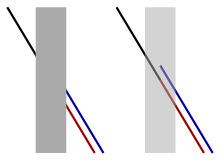Poggendorff illusion
The Poggendorff illusion is an optical illusion that is based on our perception of the interplay between diagonal lines and horizontal or vertical edges. It consists in the apparent relative displacement of the two segments of a line parallel to the edges of a beam which it crosses at an angle and is interrupted by it. It is named after Johann Christian Poggendorff , who first described it in 1860.
history
Johann Christian Poggendorff was the editor of the magazine to which Johann Karl Friedrich Zöllner had submitted a work on the perception deception that was later named after him . On a drawing in this work he discovered this deception, as Zöllner confirms:
"... Fig. 4 shows yet another illusion to which Mr. Prof. Poggendorff had the kindness to draw my attention. This is the vernier-like displacement of the halves of the horizontal stripes on both sides of the longitudinal stripes. "
observation
The illusion also depends on the angle that the crossing line makes with the bar, as well as on the orientation of the entire figure. It shows a minimum when the crossing line is horizontal or vertical.
Context elements can change the deception. Two points on the edge of the bar, symmetrical to the center of inversion, increase or decrease the effect.
interpretation
The effect could be explained both by an apparent increased perception of the acute angle between the line and the bar as well as by an apparent change in direction in the line extension in the bar area. Wenderoth, Beh, and White, in one experiment, made a slanted line below 45 ° end on just one vertical line (excluding the second, which simulates the bar). The imaginary extensions of the test line both turned out to be slightly bent towards the horizontal. However, the effect was significantly stronger on the side where the test line touched the vertical line and increased when the test line was shortened. This is consistent with the observation that a line broken by a bar appears to miss its respective extension. According to this, the deception effect relates primarily to the direction of the assumed continuation of the line in the area covered by the bar.
Similar deceptions
In Walter Ehrenstein's book, several examples of comparable effects are listed, including the case where a bar vertically partially covers a Gothic arch in such a way that an edge goes through the tip.
Another variant is the asymmetrically divided circle. Left picture: The black circle appears larger than the circle, of which only the small red segment to the right of the bar is visible, if you add it to the full circle. The picture on the right shows that they have the same radius. The illusion becomes much smaller if you turn the figure 45 ° to the left (so that the upper ends of the circle are horizontally opposite each other) or if you simply tilt your head to the right.
Individual evidence
- ↑ F. Zöllner: About a new kind of pseudoscopy and its relation to the movement phenomena described by Plateau and Oppel. In: Annals of Physics. 186 (7), 1860, pp. 500-525. doi: 10.1002 / andp.18601860712 .
- ^ DJ Weintraub, DH Krantz, TP Olson: The Poggendorff illusion: consider all the angles. In: Journal of Experimental Psychology: Human Perception and Performance. 6, 1980, pp. 718-725.
- ^ DJ Weintraub, DH Krantz: The Poggendorff illusion: Amputations, rotations, and other perturbations. In: Perception & Psychophysics. 10, 1971, pp. 257-264.
- ↑ J. Ninio, JK O'Regan: Characterization of the misalignment and misangulation components in the Poggendorff and corner-Poggendorff illusions. In: Perception. 28, 1999, pp. 949-964.
- ^ WA Kreiner: The Poggendorff Illusion - dots as context elements. 2013. doi: 10.18725 / OPARU-2627
- ^ P. Wenderoth, H. Beh, D. White: Perceptual Distortion of an oblique Line in the Presence of an Abutting Vertical Line. In: Vision Research. 18, 1978, pp. 923-930.
- ↑ W. Ehrenstein: The holistic determination of facial perception and the complex qualities of the visual sense and other senses. In: Problems of holistic psychological perception theory. JA Barth, Leipzig 1954, pp. 153-154.

